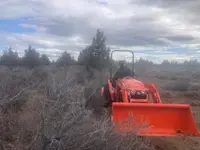
Services
This is our first step in our process which includes a site visit to evaluate the current risk of your property to fire. During this visit we will investigate your property for high-risk areas, discuss defensible space needs, and treatments for reducing fuel loads. At the conclusion of our visit, we will then prepare a management plan which could include a multiphase approach for reducing wildfire risk, methodically for achieving landowner goals, and timeline for completion. Often, the management plan created for your property can be used to apply for grants and cost shares programs that would pay for our services. This service is a A-Z product from learning about your property's risk to implementation which can save you time and money on costly mistakes or property loss.
Native brush and grass can provide nice landscaping, privacy and wildlife habitat to your property; but if not managed and not strategically located it can become a fuel hazard. Mowing can provide a solution to managing vegetation on your property in order to protect it from wildfire. We provide a variety of mowing techniques ranging from full cutting to a mosaic approach leaving only desired native vegetation. Brush mowing is an effective fuels reduction technique that rearranges fuels in order to lower fire intensity and flame length. Mowing results in the brush mulched which enriches soil nutrients, controls dust and noxious weed spread.
Tree thinning and trimming is achieved by selecting desired trees to protect by reducing stand density around it and raising the residual canopy height. This method is achieved by hand thinning and trimming with chainsaws. Tree thinning and trimming will increase residual tree's health, vigor and resistance to fire, insect and disease mortality. Slash/debris created from this step can be hand or machine pile or lopped and scattered.
Debris piling done with sweat and a lot of muscle. Debris resulting from tree thinning, trimming or hand brush grubbing would be cut and hand piled. The size of piles is determined by the landowner disposal preference, i.e. burn, chipping, or leave in place. If pile burning is preferred, then the size of the pile is determined by your county pile burn restrictions. Additional charges could apply if pile location is significantly further from treatment location.